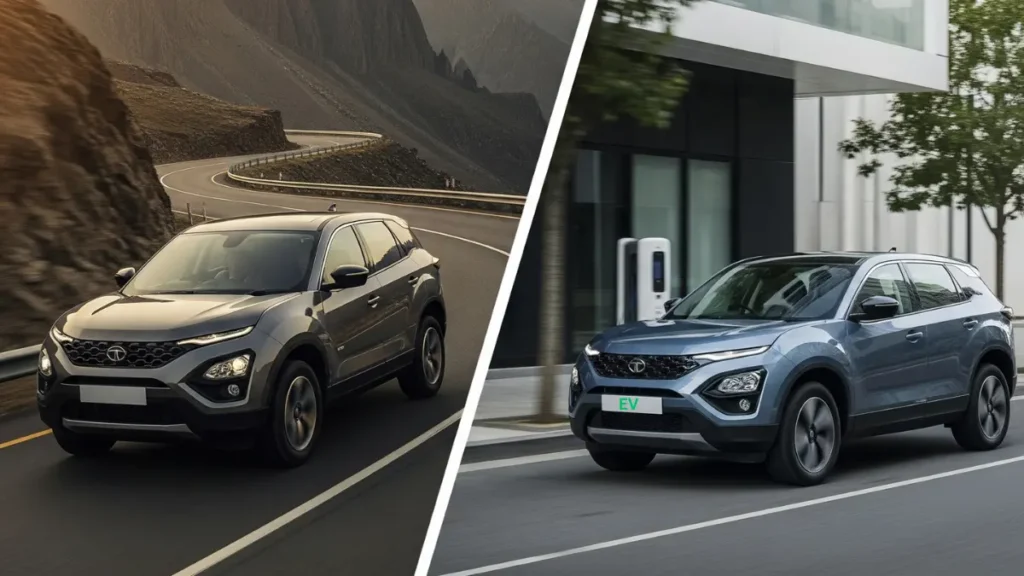Tata Motors is shaking things up in the SUV space with the upcoming Tata Harrier EV, which will soon be sold alongside the tried-and-tested Harrier Diesel. But with two powertrains under the same badge, many buyers are wondering — which one actually suits your needs?
Let’s take a detailed look at how the Tata Harrier EV vs Harrier Diesel comparison plays out — in design, performance, features, range, and overall usability.
Design and Looks
At first glance, both versions of the Harrier look aggressive and stylish, staying true to Tata’s bold SUV language. However, the Harrier EV carries a slightly more futuristic vibe. The closed-off grille, new LED light bar, and some blue EV highlights set it apart visually.
Meanwhile, the Harrier Diesel stays closer to the ICE design language — rugged, with a wide air intake, chrome accents, and a more muscular appeal.
Quick Comparison
| Feature | Harrier Diesel | Harrier EV (Expected) |
| Engine / Platform | 2.0L Kryotec turbo-diesel | Gen 2 EV Architecture (Sigma platform) |
| Power | 170 PS | Dual-motor setup (AWD expected) |
| Torque | 350 Nm | Not specified |
| Transmission | 6-speed MT / 6-speed AT | Not applicable (electric drivetrain) |
| Drivetrain | Front-Wheel Drive (FWD) | All-Wheel Drive (AWD) expected |
| Drive Feel | Solid highway cruiser, strong mid-range pull | Not specified |
| Range | Not applicable | Claimed ~500 km (real-world ~400+ km) |
| Charging | Not applicable | Fast charging support (0–80% in under 60 mins estimated) |
With instant torque and zero emissions, the Harrier EV promises quicker off-the-line performance, especially in city conditions. On the other hand, the diesel version is a known performer for long-distance drives and towing loads.
READ:- 2025 Renault Triber Facelift Launched
Cabin Experience
Inside, both versions are expected to offer a premium cabin. Tata has recently updated the Harrier with a 12.3-inch touchscreen, panoramic sunroof, ventilated seats, and wireless Android Auto/Apple CarPlay.
The Harrier EV may carry forward the same layout, with additional EV-specific graphics, regen modes, and drive selectors. Expect a cleaner center console and possible OTA update capabilities.
Running Costs & Maintenance
This is where EVs really shine.
- Harrier Diesel: Approx ₹6–7/km running cost (depending on fuel price and driving style)
- Harrier EV: Estimated ₹1–1.5/km (based on electricity rates)
EVs also have fewer moving parts, which means lower maintenance over time. No oil changes, fewer filter replacements, and less mechanical wear.
Range Anxiety vs Refueling
This is still a genuine concern for some.
- Diesel Harrier gives you a full tank range of 800+ km. Refueling takes 5 minutes at any pump.
- EV Harrier might offer 400–500 km range, but you’ll need to plan around charger availability. Fast charging helps but still takes longer than diesel refueling.
Pricing and Value
The Harrier Diesel currently starts around ₹15.5 lakh (ex-showroom), going up to ₹25 lakh for the top variant.
The Harrier EV is expected to launch in late 2025 with prices starting around ₹21–₹30 lakh (ex-showroom). There will likely be incentives for EV buyers, but initial cost will still be higher.
Final Thoughts: Which One Should You Pick?
When it comes to Tata Harrier EV vs Harrier Diesel, the decision depends entirely on your lifestyle.
- Choose Harrier Diesel if:
- You do frequent highway trips
- You want tried-and-tested performance
- You prefer traditional refueling convenience
- You do frequent highway trips
- Go for Harrier EV if:
- Your daily usage is mostly city-based
- You have home charging access
- You’re ready for a cleaner, future-ready drive
- Your daily usage is mostly city-based
Both options bring something unique to the table — and Tata has done well to cater to both traditionalists and future-focused drivers.

